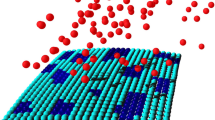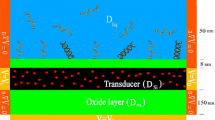Abstract
This paper proposes a maximum likelihood estimation (MLE) method for estimating time varying local concentration of the target molecule proximate to the sensor from the time profile of monomolecular adsorption and desorption on the surface of the sensor at nanoscale. Recently, several carbon nanotube sensors have been developed that can selectively detect target molecules at a trace concentration level. These sensors use light intensity changes mediated by adsorption or desorption phenomena on their surfaces. The molecular events occurring at trace concentration levels are inherently stochastic, posing a challenge for optimal estimation. The stochastic behavior is modeled by the chemical master equation (CME), composed of a set of ordinary differential equations describing the time evolution of probabilities for the possible adsorption states. Given the significant stochastic nature of the underlying phenomena, rigorous stochastic estimation based on the CME should lead to an improved accuracy over than deterministic estimation formulated based on the continuum model. Motivated by this expectation, we formulate the MLE based on an analytical solution of the relevant CME, both for the constant and the time-varying local concentrations, with the objective of estimating the analyte concentration field in real time from the adsorption readings of the sensor array. The performances of the MLE and the deterministic least squares are compared using data generated by kinetic Monte Carlo (KMC) simulations of the stochastic process. Some future challenges are described for estimating and controlling the concentration field in a distributed domain using the sensor technology.
Similar content being viewed by others
References
H.-N. Umh, H. H. Shin, J. Yi and Y. Kim, Korean J. Chem. Eng., 32, 299 (2015).
S. R. Ahmed, K. Koh, E. Y. Park and J. Lee, Korean J. Chem. Eng., 30, 1825 (2013).
S. Saito and A. Zettl, Carbon Nanotubes: Quantum Cylinders of Graphene, Elsevier (2008).
A. A. Boghossian, J. Zhang, P. W. Barone, N. F. Reuel, J. H. Kim, D. A. Heller, J. H. Ahn, A. J. Hilmer, A. Rwei and J. R. Arkalgud, ChemSusChem, 4, 848 (2011).
L. Cognet, D. A. Tsyboulski, J.-D. R. Rocha, C. D. Doyle, J. M. Tour and R. B. Weisman, Science, 316, 1465 (2007).
P. W. Barone, S. Baik, D. A. Heller and M. S. Strano, Nature Mater., 4, 86 (2005).
D. A. Heller, E. S. Jeng, T.-K. Yeung, B. M. Martinez, A. E. Moll, J. B. Gastala and M. S. Strano, Science, 311, 508 (2006).
J. H. Kim, J. H. Ahn, P. W. Barone, H. Jin, J. Zhang, D. A. Heller and M. S. Strano, Angew. Chem., 122, 1498 (2010).
H. Jin, D. A. Heller, M. Kalbacova, J.-H. Kim, J. Zhang, A. A. Boghossian, N. Maheshri and M. S. Strano, Nature Nanotech., 5, 302 (2010).
H. Jin, D. A. Heller, J.-H. Kim and M. S. Strano, Nano Lett., 8, 4299 (2008).
J. Zhang, A. A. Boghossian, P. W. Barone, A. Rwei, J.-H. Kim, D. Lin, D. A. Heller, A. J. Hilmer, N. Nair and N. F. Reuel, J. Am. Chem. Soc., 133, 567 (2010).
J.-H. Kim, D. A. Heller, H. Jin, P. W. Barone, C. Song, J. Zhang, L. J. Trudel, G. N. Wogan, S. R. Tannenbaum and M. S. Strano, Nature Chem., 1, 473 (2009).
K. A. Fichthorn and W. H. Weinberg, J. Chem. Phys., 95, 1090 (1991).
T. Jahnke and W. Huisinga, J. Math. Biol., 54, 1 (2007).
A. A. Boghossian, J. Zhang, F. T. Le Floch-Yin, Z. W. Ulissi, P. Bojo, J.-H. Han, J.-H. Kim, J. R. Arkalgud, N. F. Reuel and R. D. Braatz, J. Chem. Phys., 135, 084124 (2011).
Z. W. Ulissi, J. Zhang, A. A. Boghossian, N. F. Reuel, S. F. Shimizu, R. D. Braatz and M. S. Strano, J. Phys. Chem. Lett., 2, 1690 (2011).
Z. W. Ulissi, M. S. Strano and R. D. Braatz, Comput. Chem. Eng., 51, 149 (2013).
M. Kishida and R. D. Braatz, Optimal spatial field control of distributed parameter systems, American Control Conference 2009, IEEE, 32 (2009).
E. L. Lehmann and J. P. Romano, Testing statistical hypotheses, Springer (2006).
H. Jang, J. H. Lee, R. D. Braatzf and K.-K. K. Kim, Comput. Chem. Eng., 63, 159 (2013).
M. Kishida, D. W. Pack and R. D. Braatz, State-constrained optimal spatial field control for controlled release in tissue engineering, American Control Conference 2010, IEEE, 4361 (2010).
Author information
Authors and Affiliations
Corresponding author
Additional information
A preliminary version of this manuscript was published as H. Jang, J. H. Lee, and R. D. Braaz, Maximum-Likelihood Parameter Estimation for Detecting Local Concentration from a Carbon Nanotube-based Sensor, in the 10th International Symposium on Dynamics and Control of Process Systems, Mumbai, India.
Rights and permissions
About this article
Cite this article
Jang, H., Lee, J.H. & Braatz, R.D. Estimation of local concentration from measurements of stochastic adsorption dynamics using carbon nanotube-based sensors. Korean J. Chem. Eng. 33, 33–45 (2016). https://doi.org/10.1007/s11814-015-0124-9
Received:
Accepted:
Published:
Issue Date:
DOI: https://doi.org/10.1007/s11814-015-0124-9




